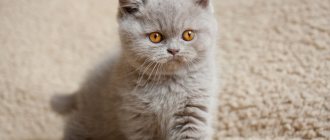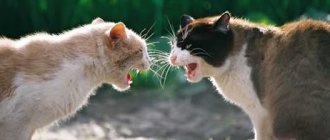Every owner of a British cat sooner or later must make a decision: does he need mating of the animal, and if so, how best to carry it out? To organize this process correctly, you must know how puberty occurs in cats and female cats in order to understand whether they are ready for mating, as well as study all the rules for organizing mating and preparing the animal for it.
When does puberty begin in cats?
For owners of females, the problem of mating their pet becomes relevant already at 6-7 months of their pet’s life: it is at this time that the cat begins her first heat. Of course, cats should not be mated at this moment, because the animal is still developing (and puberty and physical maturation are not the same thing!), but even then you need to think about future searches for a partner.
The situation is similar for owners of males: cats mature by 7-8 months, but if at this age castration is quite appropriate, then cats do not yet need mating: the animal is not yet ready for it!
If you don't know how old your pet is, the onset of puberty can be determined by certain changes in his behavior.
In cats this manifests itself in:
- the appearance of more characteristic behavior (if previously the kitten was affectionate and gentle, now it may become a little aggressive),
- attempts to mark territory,
- attempts to adapt various soft things for your sexual needs.
The signs of maturation in a cat are as follows:
- loud calling meow,
- changes in gait (during estrus, the cat raises its tail and arches its back),
- rolling on the floor,
- changes in character - some cats become more aggressive, and some, on the contrary, become affectionate.
Pros and cons of the British chinchilla breed
The advantage of the British of any color is the complete absence of aggression. These are not vindictive cats who will try to find a common language with everyone, and if that doesn’t work out, they will simply try to hide from the sight of an overly familiar person.
British chinchillas make great pets.
An adult chinchilla is almost invisible at home: it prefers to rest, curled up in a ball, or quietly follow its owner. They do not tear furniture or damage wallpaper. With proper care, they will delight you with your love for many years. Beautiful appearance is one advantage of the British chinchilla over other breeds. they leave no one indifferent.
British chinchilla cats are the rarest and most expensive. Their beauty is complemented by excellent character and long life expectancy. Therefore, such a cat will make an excellent pet.
I like it I don't like it
When should you think about mating?
A young cat can be mated with a male cat when the cat reaches puberty and is strong enough to become pregnant and give birth to kittens without risking her health. It is better to skip the first two heats, and untie them on the third. According to the rules of most clubs, mating of cats with a rating of at least “Very Good” received at a cat show is allowed, and cats with Champion titles and above can be mated without having to undergo exhibitions before mating. According to the same rules, a cat should not give birth to kittens more than three times every two years.
The first mating in cats is easiest before the age of one and a half years. If the cat was not untied (she did not have kittens) before two years, then problems may arise.
Remember two rules:
Mating cats should not be carried out during the first heat, even if it comes late (this can end very unfavorably for the animal!), two weeks before mating the animal should not be given any vaccinations.
Also, you should not delay with the mating itself: this can lead to various anomalies (exhaustion of the animal, disruption of the estrus cycle, or even the development of polycystic disease), so it is better to take care of selecting a partner for your pet, regardless of whether you want to do it!
Signs of heat
Readiness for mating manifests itself not only by a change in the pet’s behavior. When determining the cycle, the owner should also pay attention to physiological symptoms.
The first period of maturation in a young female occurs at the age of six months to a year. Early or late onset of puberty is considered a defect and a reason for withdrawal from breeding.
Physiological signs
Signs of the female’s readiness for reproduction make themselves felt already in the first two days:
Discharge. The pet spends more time than usual on the toilet of the genitals. The discharge has no color or strong odor. There are owners who prefer to put special panties on their pussy. This is an unnecessary precaution - the cat is able to keep itself clean without outside help;
Frequent urge to urinate. The pet goes to the toilet more often than usual, sometimes choosing unusual places. This symptom usually manifests itself when there is a male nearby;
Decreased appetite. Pussy does not show the usual interest in food.
The listed signs do not necessarily indicate readiness for mating. If such symptoms appear that are not related to the breeding season, the animal needs to consult a doctor.
Behavioral signs
The behavior of a female in estrus is imprinted by individual character traits and can change depending on her mood.
Sound signals. The female calls her partner, showing ingenuity, alternating loud heart-rending screams with purring or long tirades with changing tonality. Most of the “concerts” take place (last) in the dark.
Tenderness and sociability. Even a timid creature that hides at the slightest sign of danger becomes a sweet and affectionate animal during the heat period. The cat needs tactile contact, rubs against various objects or rolls on the floor.
Pose with raised tail. The pussy presses its belly to the floor and raises its tail.
The desire for freedom. The female forgets caution and looks for opportunities to go free in search of a cat. You need to vigilantly monitor the cat and block the pet’s escape routes.
Owners must understand that their pet’s behavior is regulated by instincts. It is useless to punish an animal for displaying biological nature; it is better to try to help the pussy get out of an unpleasant state.
Photo - Cat in heat
Mating cats: basic rules for owners
First of all, you should remember that you should not abuse drugs that suppress or stop estrus. Most often, their use for their intended purpose is not effective, but can lead to hormonal imbalance in the animal’s body or cause serious illness. Therefore, it is best to immediately realize that you will need mating between a cat and a cat, and you need to prepare for it according to special rules.
So, cat owners should remember that:
A suitable partner for your pet must be found in advance (those involved in breeding will need to look for him in the appropriate club, and those who need regular mating can do this through advertisements or at cat shows; if a suitable partner is not found immediately , consult cat clubs where they can help you find a match for your cat);
Before mating, the cat must be vaccinated against the main infectious diseases: rhinotracheitis, rabies, calicivirus infection and panleukopenia (included in the complex vaccination), and if mating conditions require it, additionally against chlamydia and lichen (stamps in the veterinary passport no more than 1 year from the date of the first vaccinations and at least 1 month before mating).
The cat must be dewormed 14 days before mating (to remove worms) (the cat should be checked in the same way!);
Before the mating process itself, the cat (and male cat!) needs to have its claws trimmed so that the animals cannot injure each other;
It should be remembered that preparing a cat for mating does not involve washing it, because this can destroy its natural scent that is attractive to the cat.
Suitable time for mating
The period of puberty in the British begins in the period from 7 to 9 months, of course, taking into account the individual characteristics of each animal.
The first mating should take place no earlier than 10 months, so that the cat is strong enough to mate and bear offspring.
If mating is carried out earlier, pregnancy for a cat can result in many complications.
It is important to skip the first 2 heats of a female and pair her with a male only for the 3rd. The optimal breeding period for British cats is from 10 months to 1.5 years. When a cat turns 2 years old, the chances that she will come into contact with a cat are minimal.
Mating cats: basic rules for owners
They are the ones who must control the mating process and help the animals if necessary;
The cat owner will have to ensure that two “untied” animals do not mate - this can cause mental and physical trauma to them;
The owner of the cat accepts the cat on his territory, so he must provide it with the opportunity to independently get out of the carrier and get acquainted with the cat, and, if necessary, take refuge in a secluded place where a scared or aggressive cat can “sit out” for a while and get used to the changes in its life.
Preparation for mating during breeding
Owners of breeding animals should also remember special rules: before breeding a cat, they must agree on the terms of payment (if necessary), as well as the duration of the female’s stay in the cat’s owner’s house. It is advisable to do this in writing, and in this case, a cat mating agreement can help, which professional breeders can help draw up.
In addition, serious breeders are sure to collect as much information as possible about the origin of the cat chosen to pair with their pet. This implies:
- identification of possible genetic defects in the animal (bad bite, poor coat, uncharacteristic colors, etc.),
— examination of kittens from other litters of the cat (if the cat has already had offspring),
- checking whether the cat is prepotent - that is, whether he can pass on good qualities and characteristics to his offspring.
If you find any deviations that suit the owners of the cat, you should definitely include all the data about them in the cat mating agreement. Only this will save their owners from subsequent proceedings.
What should you pay attention to and who should you breed Scottish Straight with?
There is only one answer to the question of who can breed a Scottish Straight cat with. Mating of straight-eared Scottish cats Scottish Straight
carried out only with direct relatives of these animals, namely Scottish Folds. The excellent compatibility of genes and breed characteristics allows you to breed animals with wonderful appearance and excellent health indicators. The gene present in folds is predominant and main, therefore mating with a representative of a similar breed is disastrous for animals, as it leads to the development of abnormalities and chronic diseases in kittens.
The first mating is the most exciting for the owner. In order for the result to be positive and everything to work out as it should, it is necessary to select a healthy breeding male who will be somewhat older and more experienced than a young cat. However, the first Scottish Straight pregnancy may be unsuccessful. This happens if the cat suffered stress and did not allow the cat near her or was not at all ready for this process. When preparing for mating, you should carefully prepare and take into account all the nuances of the subsequent meeting between male and female.
Important points to take into account when knitting:
- Both partners must be treated for parasites and vaccinated. The presence of vaccinations must be checked according to the animal’s documents;
- The cat is always sent to the cat's territory when mating. Therefore, she needs to be provided with comfortable conditions, her usual diet and her own tray with filler, since it has her scent;
- Cats don't always welcome their partners. Therefore, for the safety of animals, it is worth trimming their claws;
- Animals need to be given time to get to know each other and get used to the smells;
- Pets should not be forced to mate if one of them is not ready for this.
The main rules for mating the Scottish Straight
:
- The color and external features of the cat must correspond to the norm. It is important to pay attention to the uniformity of color, body proportions and coat. The coat should be smooth and free of dandruff. If the cat’s hair is very matted, and there is discharge from the eyes and nose, it is better to completely abandon mating;
- The condition of the cat for mating must be satisfactory. It is important that the male chosen for mating has a strong, healthy physique and is sufficiently active. A lethargic and apathetic cat is not the best option, so it is better to refuse mating with such a representative;
- When choosing a Scottish Fold
, it is important to pay attention to the ears and their folding. The ears should be symmetrical and not extend beyond the cat's skull. Cats with folds on their ears are especially prized. They are rare and mating with them costs many times more.
How is the mating done?
The first signs of heat: the cat begins to purr, becomes overly affectionate - constantly demands attention to itself, rubs against all objects and your legs, if you, stroking its back, reach its tail, it rolls its tail to the side, the tail trembles, and the cat begins to stamp his hind legs. Immediately pick up the phone and call the cat’s owners and arrange a mating.
It is best to schedule a “meeting” between male and female cats on the 3rd-5th day of the cat’s estrus. At this time, mating will be most effective, although in some breeds of cats ovulation may not occur earlier than the 9th day. As a rule, mating takes place on the territory of the cat, where all conditions for mating cats must be provided.
However, the owner of the female will also need to prepare by taking with him:
- pet's toilet
— supply of food and water for 1-3 days
- bowls for food and water
- a carrier that the cat is accustomed to; if necessary, the animal can hide in it and rest.
- a copy of the pedigree
The cat's front claws need to be trimmed. The cat's appearance should not confuse the cat's owners - the cat should look well-groomed, well-fed, clean, without streaks under the eyes, with clean ears, and of course, without fleas.
You can recognize a cat’s readiness for mating by its behavior: it begins to flirt with the cat itself, initiating sexual arousal in him. At the same time, when the cat tries to approach, the cat begins to show dissatisfaction, and the male has to recoil and pretend that his partner is not at all interested in him. This should be repeated several times, but sooner or later the cat will lose vigilance, and then the cat will sit down. If this is the first mating of a cat, and the animal is nervous, its owner should calm it down if possible and make sure that the cat does not cause any injury to the cat.
If everything is in order, the cat is in heat, the cat has shown interest in her and began courtship, then you can leave the bride and groom alone. Most often, the first mating occurs at night, when all the people have dispersed, the sounds have died down, the lights are turned off, and no one bothers our couple.
As a rule, the next morning it is already clear that the wedding has taken place: the cat’s behavior changes, she no longer hisses at the cat, allows him to lie next to her and even lick her fur coat. Despite the fact that the cat is tamed and itself calls the cat for the next mating, each time, after the end of the action, she ritually hits the cat with her paw. Therefore, cats' claws should be trimmed at home, before going to the wedding. There are cases when a cat did not have time to jump away and received an eye injury. It is believed that the cat experiences pain at the moment of copulation, which is why it screams terribly and attacks its lover with “cuffs.” Experienced cats quickly recoil to a safe distance until the cat calms down. The pain subsides after a few seconds, and then the cat, having put herself in order, begins to roll all over the floor with pleasure, and the cat watches her carefully.
A cat can sit for a whole day without letting the cat near. There are calm, “compliant” individuals, and there are extremely aggressive ladies. There are impudent ones who come to the cat’s territory and behave as if they have always lived here. And there are cowardly, scared cats that try to hide and hide in any conceivable or inconceivable crevice.
The cat first tries to approach the cat, but, as a rule, gets hit in the face. And then the persuasion begins. The cat sings songs, periodically uttering a questioning “mrr”? The cat hisses at the cat and waits just as long as it considers necessary so as not to lose its dignity. Each cat has its own ideas about this time. There is no general rule here. It is interesting that the same cat with different cats can behave differently. If the cat is timid and shy, then the cat can play along with her and pretend that he himself is afraid of her, then the cat becomes bolder and begins to flirt with the cat herself. If a cat behaves defiantly, the cat may come up, slap her in the face and grab her by the scruff of the neck. The cat reflexively goes limp and mating occurs. Such matings can occur 10-15 or more in one day. It all depends on the cat’s health and how sexy he is.
After a day, sometimes after two days, the cat loses interest in the cat. The cat can still “ask for a cat” for a few more days. This is not at all a sign that the cat is not mated. She simply cannot stop at the “motor” level. And the cat has already realized that he has fulfilled his marital duties, apparently because the cat’s smell that attracts his attention disappears.
Now count 65-66 days from the first day of mating and wait for the birth. If the cat does not become pregnant, you will understand this after about three weeks, or when the next heat begins. Be sure to inform the cat's owner about this in order to comply with formalities - after all, the unsuspecting cat will be expecting children and, accordingly, its owners - payment for mating. Usually in such cases the cat is brought to the next heat for re-mating under the same conditions.
Video: Kittens for you! Purebred Scottish kittens of rare and classic colors
Naturally, when acquiring a new color, the descendants of such experimental matings received certain deviations in type. The most common flaw in the type is an “exotic” profile, i.e. a pronounced stop in the line of transition from the forehead to the nose, characteristic of exotics and Persians. Another disadvantage inherent in some breed lines is the elongated, soft (“downy”) coat - also a heritage of the Persians.
However, experimental matings were also used to correct the shortcomings of the breed type of British cats. For example, purebred British blue dogs are heavy, massive with good short and thick hair, may have small eyes, pale yellow color, large ears and dark hair.
To obtain large, round, wide-set eyes, many large breeders of the British breed very successfully used classic-type Persian cats in their breeding. A striking example of this is the Dutch nursery “Bagoas”, known for its beautiful animals with huge, wide-set eyes of rich color - the original backbone of the nursery was made up of animals that were bred using the blood of Persians and exotics.
Currently, experimental matings of British cats with cats of other breeds are used quite rarely. The main task of modern breeders is to improve the breed qualities of animals within certain color groups, i.e. solving problems specific to specific colors.
Non-standard situations that may occur when mating cats: rules of conduct for owners
Unfortunately, just like humans, cats and kittens can also experience incompatibility. Sometimes its manifestations are easily overcome, but there are times when this can lead to additional problems, so you need to initially be prepared for this and know how to help animals if necessary.
Situation No. 1: animals do not match each other in size (the cat is larger than the cat)
In this case, the cat, grasping the female's withers with his teeth, cannot impregnate the cat, because the back of his body rests on her back. In such a situation, the owner must help the cat by grabbing the withers with his hands and giving the male the opportunity to grab the skin below the withers.
Situation No. 2 . The cat falls on its side during mating.
In such a situation, mating of cats should occur with the constant support of the owners, who must put the animal in the right position. However, some cats can impregnate cats even if they are lying on their back or side.
Situation No. 3 . The cat won't let the cat near.
The most severe case, which most often requires the intervention of a specialist, is the one who must insert a special probe into the cat’s vagina, after which the animal will let the cat in on its own. In rare cases, patting the cat’s tummy or injecting a drug that induces ovulation can save the situation (the drug for the injection should also be selected by a veterinarian!).
Situation No. 4. Some cats, finding themselves in an unfamiliar place, on foreign territory, “forget” about the purpose of their visit.
Don’t rush things and let the animals get used to it; usually mating of two healthy animals occurs without any help from humans.
Situation No. 5. The cat's owners are mistaken in assuming that she is in heat.
However, the cat detects this instantly. As soon as the cat is released from the carrier and the cat sniffs her tracks, it immediately becomes clear from his behavior whether she is in heat or not. The cat either gets excited and announces in a loud voice that he is ready to reciprocate, or indifferently turns away from the guest and leaves, or even demonstratively goes to bed in her presence. Then you will have to take the failed bride home. Please note that in such a situation your cat begins to get nervous (new environment, new people, and even a cat nearby). She becomes aggressive or, conversely, becomes depressed. This, of course, adds trouble and inconvenience to the groom’s hosts.
British chinchilla breed
As its name suggests, the breed originated in Great Britain. But others that originated in other countries were also used in breeding, for example, Persian cats. British cats as a breed were finally formed at the end of the 19th century. But the standard was finally approved only in the 80s of the 20th century. Then work began on developing new colors.
History of origin
The British Golden Chinchilla got its beautiful color by crossing the Persian Chinchilla breed with other breeds that have a solid color, with the British having a smoky coat color.
But the breeders were not satisfied with the eye color of the offspring, which changed from turquoise green to greenish yellow. In order to preserve the original eye color, breeders tried to cross cats with green-eyed tabbies. However, the result was unsatisfactory. For this reason, it was decided to cross the first generation animals with each other, periodically adding Persian blood.
The British golden chinchilla was bred according to the same principles as silver-colored individuals. The difference is that the breed was based on an already bred silver chinchilla. Since the gene responsible for the golden coat color had already been received from the Persian ancestors, breeders only had to fix it.
Golden chinchilla color.
Should you give your cat birth control?
Usually cats, not getting a cat during the onset of estrus, move on to the next active phase - they scream day and night, preventing their owners and their neighbors from sleeping. Owners, unable to withstand such torture, often resort to advertised hormonal drugs (Contrasex, Anti-Meow, etc.), after the use of which hormonal disorders occur in cats, which cause severe diseases of the reproductive system - infertility, endometritis, pyometra (“purulent uterus”), malignant neoplasms, deformities of offspring, etc.
This is a very important issue that requires separate consideration. Many cat owners consider such medications to be an alternative to sterilizing their animal, but this is not true: contraceptives cause irreparable harm to your pet!
In this case, pathologies of the reproductive system can occur only after a few years, when the cat is already elderly, and you will have to either decide on a risky operation or euthanize the animal. Therefore, if you do not want to endure regular heat and the cat’s behavior after mating, it is better to immediately sterilize your pet, which will not only save you from the hassle of organizing mating, but will also protect your cat from serious and dangerous diseases.
5 / 5 ( 319 votes)
What care does a pregnant animal need?
The pregnancy of a British cat lasts about 64–70 days. Three weeks after the cats were “crossed”, you can notice that the pet’s nipples have turned pink and swollen. At the same time, she becomes gentle and calm. All that is required of you at this stage is to limit the cat from stress. It is also very important to take care of her balanced diet. Be sure to include various supplements in your daily menu.
It is believed that already a few days before giving birth, the female becomes restless and begins to arrange a secluded place. You need to place plastic wrap under the cat and sheets or diapers on top, which you won’t mind throwing away later.
The process of giving birth to kittens, as a rule, takes place without the participation of the owner. However, it is recommended to monitor the woman in labor: if she suddenly needs help, you will have to provide it.









